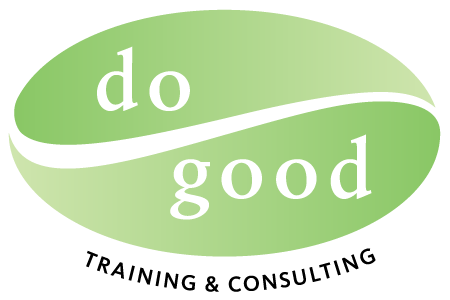Question & Answer
Dear Laura:
 Our nonprofit doesn’t have an enewsletter but plans to launch one in 2024 (we have a mailed paper newsletter). Staff investigated some enewsletter platforms comparing cost, effectiveness, integrations, etc. Then our Executive Director took the write-up to the board.
Our nonprofit doesn’t have an enewsletter but plans to launch one in 2024 (we have a mailed paper newsletter). Staff investigated some enewsletter platforms comparing cost, effectiveness, integrations, etc. Then our Executive Director took the write-up to the board.
The response? The board suggested that to save money, we keep using our paper newsletter, then begin to instead email that out as a PDF attachment to the contacts we have email for.
Yes, that’s me groaning. Please help! I know this is a terrible idea. Please help me prove all the ways in which this is wildly ineffective so we can get back on track!
-Can You Hear Me Groan?
Dear Groaning:
After taking an antacid upon reading your email, I took a stroll down memory lane, recalling a client I worked with years ago who had attempted a similar strategy, hoping they could have their cake and eat it too. After a couple of months of attaching PDFs to emails and bcc’ing a couple hundred people, they essentially landed in “spam jail.” This caused a ton of headaches for them with some contacts as well as with their ability to just engage in basic daily email communications.
In addition to the risk of going to “spam jail” and disrupting your communications, there are several other compelling reasons why sending a PDF version of your printed newsletter to hundreds of people is a supremely bad idea.
Today more than ever before, email companies are cracking down hard on spam and items that look like they could be ‘spammy’. This includes the combination of sending a lot of people (including using bcc) an email with an attachment (like a PDF). For many companies (gmail, Yahoo, AOL, etc.) the default for messages like this are to either drop them right in the Spam folder or worse, just block delivery. So, on your end while it might feel satisfying to hit “send” to 200+ people with a well-thought-out document, it’s really not time to celebrate because you’d be shocked at how many people you think you’re reaching never get or see your email. The point of sending your content is for your contacts to read it and engage with it. This shortcut is like trying to win a three-legged race by cutting your legs off.
Now for those who actually do get your email, there are a whole bunch who won’t open attachments in emails that aren’t uniquely personal (like the email being sent to them directly, one-on-one, without a personal salutation or something that makes the email look personal) and trustworthy. Just because it’s coming from Your Good Cause doesn’t mean they’ll trust it enough to risk downloading a virus. So there’s a whole bunch more of your contacts not getting your message.
Sending your newsletter as an attachment also cuts your organization off from critical metrics and engagement monitoring. This includes: who is opening your emails, who is reading them and what they’re clicking on, who’s dropping off, when people open your emails (best time to send), and lots more. Programs like MailChimp, Constant Contact, HubSpot, etc. allow you to build your enewsletter in a drag-and-drop set-up that’s easy for even novices to use. Such programs manage your contacts and their emails and track all contact activity in your enewsletter, helping you better understand what your readers like, aren’t reading, etc. These programs also allow for personalization to each sender as an automatic function. Many of these programs also allow integration with many nonprofit databases, or CRMs, that allow an additional boost in contact records by attaching activity in email sends like this to their database contact records. This integration can help you better identify potential donors, likely volunteers, and how to best engage those who are your most active supporters.
If you don’t have a formal database system (e.g., if you’re using an Excel spreadsheet to maintain contacts), then it’s likely time to review options there, too. The good news here is that many nonprofit databases (CRMs) have email programs built into their functionality, so you can build your enewsletter (and other communications!) right in the CRM with all the touch-point data coming from each send linked to each contact’s record. Some CRM options I really like for small to mid-sized nonprofits are Bloomerang, Little Green Light, and Neon.
In your case, developing a formal enewsletter – not a PDF sent as an email – will provide your organization with a deep array of valuable results. To start, your communications will more readily be delivered, avoiding spam filters or blocks. As a result, your readership will go up with more deliveries, and from a more trusted platform with personalization options to boot. Finally, with the ability to see how, where, and who is engaging, you are collecting a treasure trove of valuable information you can use to cultivate your audiences to deepen engagement with your group. This will likely mean increased donations, broader volunteerism, better event attendance, and much, much more.
Really, the cost here is 100% worth it. I’ve seen so many organizations make this leap with payoff coming back to them within just months and driving in valuable new dollars and contacts.
I hope this helps you convince your board of the importance of this investment. One thing I’ve found effective is turning the question back on them by asking them about the emails they have received in the past couple of weeks and how many they actually trusted and opened. Ask any if they’ve ever opened one only to find a virus and headaches. Then ask them if they know just how many emails they want to get that they are not getting because of spam filters blocking the type of email they are suggesting. A bit of real-life pondering just might get them back to the land of reality. Good luck!
~~~~~~~~~~~~~~~~~~~~~~~~~~~~~~~~~~~~~~~~~
Dear do good:
 I’m transitioning into a paid executive director post at a nonprofit I founded. Previously I was on the board, but with our needs (and budget) now growing, we’re adjusting our structure to be more responsive and forward-thinking.
I’m transitioning into a paid executive director post at a nonprofit I founded. Previously I was on the board, but with our needs (and budget) now growing, we’re adjusting our structure to be more responsive and forward-thinking.
Several current board members want me to remain on the board as well as serve in this new role. This really seems like a bad idea to me. Thoughts?
– What hat should I wear?
Hello Hat:
My short and quick answer to you is: you’re right. This is a bad idea. Such a dual role is ripe for both real and perceived conflicts of interests across a number of important organizational areas, including budgetary and finance issues, program and service issues or changes, and in some areas regarding staff (compensation, structure, etc.). Even with you as the single new staff member now, that last conflict can still present given the need for performance evaluations.
According to our good friends at GrantSpace, it is legal in most states for executive directors (and even other paid staff) to serve on their organizations’ boards. However, they go on to say that “it is not considered good practice, as it’s a natural conflict of interest for executives to serve equally on the entity that supervises them.” I concur.
What is a good practice (really, a requirement) is that as the new director you attend and participate in discussions at board meetings. I wholeheartedly support and recommend this.
There is one way to elevate and integrate your staff role with the board: serve as a non-voting (ex officio) member of the board. This structure, says BoardSource, can help “avoid actual or perceived conflicts of interest, questions concerning accountability, or blurring the line between oversight and execution.” They caution that it’s important to know the laws of your state regarding if this structure is permitted.
The bottom line for me is that it’s critical that you in your new role participate in board meetings. And because I always recommend avoiding even the whiff or appearance of any conflicts of interest, in most cases I do not even recommend the non-voting board role.
If you do choose to have such an ex officio seat on the board, it’s imperative that your group have a strong conflict of interest policy that outlines when it’s necessary for board members, including you, to recuse themselves from certain votes or discussions where a conflict of interest might exist.
Good luck in your new role and your growing organization!
~~~~~~~~~~~~~~~~~~~~~~~~~~~~~~~~~~~~~~~~~
Dear do good:
 I work at a nonprofit and have liked our group’s Facebook page. I’ve been liking and sharing some posts to spread the word on our work (including ones I post on behalf of the group), but got an email this week from someone in leadership asking me to not like or share posts anymore saying that ‘the public already knows we already like it.’
I work at a nonprofit and have liked our group’s Facebook page. I’ve been liking and sharing some posts to spread the word on our work (including ones I post on behalf of the group), but got an email this week from someone in leadership asking me to not like or share posts anymore saying that ‘the public already knows we already like it.’
I would think that more online activity, including from insiders like me, are great for spreading the word and raising awareness. What are your thoughts?
-If only you could see my face(book)
Hello Face(book):
Thanks for the inquiry. I’ll be honest, I’m really curious about the reasoning behind this at your organization.
Here’s my view, which I think is widely supported in the field. There are going to be rare circumstances where there may be a different answer to an inquiry like this, but 99.9% of the time, more engagement is not just better, but considered best practice – including from organizational leadership and staff.
Let’s break this down a bit.
First, some of your personal friend’s list may know you work for ABC Organization. However, many others may not. This really makes no real difference though, because in the world of marketing, sharing organizational news with others is an essential strategy for heightening awareness and driving engagement by others in your community, region, or service area. When you engage personally, you help increase post visibility to others, both in and outside your network. This informs people, reminds them, and gives them tools to also engage and share with posts. Facebook’s mysterious algorithms also reward groups for such activity and creating such unpaid organic engagement can and really should begin with your group’s leadership: board, staff, and volunteers.
Furthermore, if the public sees a post – and let’s assume here it’s a positive post – and does not see those they know to be involved in ABC Organization engaging, liking, and sharing the post, I’d think that risks looking very odd or off to them (“Wow! Not a single board or staff member likes this post about ABC Organization winning the 2019 School of the Year award? What’s up with that?”)
Even if a post was put up about you, it’s still okay to engage. For example: “ABC Organization is celebrating a fantastic teacher today: Jane Doe is marking her 10th year changing young lives with us this year. Bravo to a teacher that kids call ‘Miss Grins’ for the smile she always wears in the classroom and beyond.” It would be entirely appropriate for you to not only “love” this post, but to post in the comments something like: “It’s been an honor and blessing to touch so many lives in the last 10 years. The smile I wear on my face every day is reflective of the joy that my @ABC Organization students bring me every day in my work. Would not trade it for the world!”
And I would further share this post on your own timeline with that same or a similar comment in the area you have to preface the share with a comment. So many more people would see this great post and would help elevate ABC Organization’s awareness and drive more engagement to your cause.
A related note here: Some organizations have policies regarding social media engagement. Typically these are in place to protect groups from having employees or volunteers share information or images about clients or confidential information or items shared without authorization (like replying to a comment or inquiry online when this should instead come through official channels). I believe well-written policies strike a balance between ensuring such protections while also strongly encouraging general engagement as a part of a strong community awareness program. In fact, in most board member agreements I develop for clients, I include a clause regarding communications engagement that encourages members not only like and follow their organization’s page if they are on various platforms, but also appropriately engage with as many posts as they feel comfortable with by liking, sharing, and commenting to help with the organization’s organic outreach. (This of course does not replace, but is in addition to, other community outreach efforts that are also encouraged such word-of-mouth promotions and sharing newsletters with colleagues.) These policies I think also very appropriately apply to staff, and even volunteers, as well.
That said, you have not mentioned a policy in place here for your group. Certainly if one exists that prohibits you from engaging with your group’s Facebook page in any way, don’t risk your job. But general interactions such as likes and shares of informational posts and good news should, I think, not only be allowed but encouraged.
Bottom line: When it comes to engagement on social media, including Facebook, if you’re an employee and the post is relevant and important to you personally and/or professionally, I would definitely encourage you to engage with post. Like/love/wow it (if it’s a good post, of course) or use a sad face for something bad. If you have relevant commentary to add, I’d say feel free to do so (within professional parameters of course). If you’re able to tag anyone or another group/entity in your comment, that should also be encouraged (e.g., @Laura Huth-Rhoades – check out this upcoming volunteer opportunity at @ABC Organization!). These things will help others you’re connected with see the post, which is the entire point of Facebook. The more you, others at your organization, those who like your page, and those who have not yet engage by giving likes (or reactions), comments, and shares, the more people will see the post and learn about your cause.
And more people seeing your posts and learning more about your organization is really what you want!
Good luck!
~~~~~~~~~~~~~~~~~~~~~~~~~~~~~~~~~~~~~~~~~
Dear do good:
At our board meeting last week, a board member brought up #GivingTuesday, urging me to get something cooking for this year. I feel that while #GivingTuesday is important, we’re not yet at a point to successfully participate – we were founded last year and I’m a staff of 1. The timeline seems too short and given I’m part-time, pulling something like this off so quickly seems sketchy. I’d like to participate next year instead and give the planning needed due justice to do this right. Thoughts?
– Not wanting to give until it hurts
Dear Hurting:
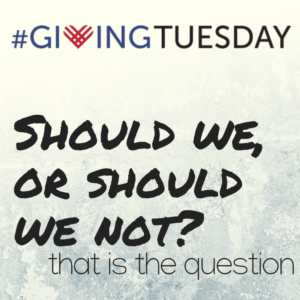 I’m glad to hear that #GivingTuesday, the annual “Global Day of Giving” that happens on the Tuesday after Thanksgiving, is on your board’s radar. It’s just a week away now.
I’m glad to hear that #GivingTuesday, the annual “Global Day of Giving” that happens on the Tuesday after Thanksgiving, is on your board’s radar. It’s just a week away now.
What I am not as excited to hear is that in mid-November, your board is entertaining the idea of just kicking off planning – and essentially directing you to side-line other important year-end needs to focus on this one-day opportunity.
Here’s why: Starting around Thanksgiving and running through year end is the time of year when most charitable dollars are donated. In fact, nearly 40% of all giving takes place in this month-long period.
Started in 2012, #GivingTuesday has been an increasingly important tool for nonprofits to raise year-end funds, largely online. In fact, #GivingTuesday saw a significant increase in donations last year, growing from $177 million in online donations in 2016 to a whopping $300 million in 2017—a 70% increase!
That said, #GivingTuesday is neither a panacea for year-end giving, nor is this fundraising tool a replacement for other year-end development needs such as mailed appeals. It should be considered – and approached – with balance and due diligence, especially for smaller, newer nonprofits like yours.
As they say, timing is everything, and here timing is not on your side. While I want to see your nonprofit start-up thrive, my advice to you sounds like what you already have in mind: focus on your existing year-end fundraising needs this year, then in Spring, begin planning for next year’s #GivingTuesday needs. Ramp-up to this event, including building your tech-savviness, your online presence, your board’s training and involvement in fundraising, and finally expanding both your impact and your donor and prospect base. Use your fundraising committee – or an ad-hoc committee of it – to develop robust #GivingTuesday plans and make sure these plans merge and compliment all other organizational giving plans, including and especially year-end giving.
Update your board throughout the year, ensuring that when your campaign launches, they all stand ready – as a team – to make the campaign a success. #GivingTuesday should never just be a staff-driven event and is much more than just a few social media posts or a new page on your group’s website.
Here are some basic questions to ask if you are #GivingTuesday ready:
- Do you have at least 2-3 months to plan your efforts?
- How strong is your “donate” presence online? How easy is it for donors to make online gifts? Are these pages well-done and compelling?
- Is your board, some of your volunteer base, and some key staffers willing and able to help?
- Do you have a specific goal and cause, project, or need around which to fundraise for such a one-day, time-limited event?
- Do you have a budget set aside for the needs to make this campaign a success? Just because this campaign is mainly online doesn’t mean it’s free.
- How strong is your organization’s social media engagement? Are those linked with you on your pages truly engaged with you – beyond just “likes” or “follows”?
- Do you have a strong email list and a better-than-average e-newsletter? What do open rates look like? Click-through rates? How often are you able to successfully create giving calls-to-action from this communication?
- How engaged is your board in fundraising? How many of them are strongly engaged in social media and willing and able to use their accounts to create #GivingTuesday calls-to-action for your campaign?
- Do you have the people-power to thank donors in a timely fashion during the day and in the days following?
From the information you’ve given me, it sounds like while #GivingTuesday will be a useful tool for many other nonprofits, for this year, your smaller nonprofit would be wise to avoid an 11th hour attempt that’s likely to pull you away from more currently useful year-end fundraising needs.
Here are some resources to get you set for your #GivingTuesday events, whether for this year or next!
- https://www.givingtuesday.org/
- https://nonprofitquarterly.org/2017/11/27/giving-tuesday-wash-small-nonprofits-forum-experimentation/
- https://www.causevox.com/givingtuesday-campaign-planning/
- https://www.classy.org/blog/6-tips-to-maximize-your-givingtuesday-campaign/
- https://donorbox.org/nonprofit-blog/giving-tuesday-ideas-2018/
- https://www.neoncrm.com/10-year-end-giving-statistics-every-fundraiser-should-know
Good luck!~~~~~~~~~~~~~~~~~~~~~~~~~~~~~~~~~~~~~~~~~
Dear do good:
In June, we held our first ever annual dinner. It was lots of work and didn’t raise much (if you count staff time, we actually lost money). However, the event was pretty well-received and we already have some folks asking if we’ll do it again. Our board was disappointed that we didn’t raise tons of money and says to nix the idea. A couple want to try something different event-wise next year to raise more money (a golf outing was brought up).
Do you have any advice for us?
– Caught Between a Board & a Hard Place
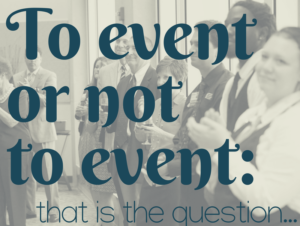
Dear Board & Hard Place:
This is a very common – and excellent – question. Special events, like annual dinners (and golf outings and ___-a-thons) present both unique opportunities and big challenges for nonprofits.
On their face, special events seem like a good idea – everyone’s doing them, right? But events done without the proper planning and without realistic expectations or goals, can leave organizations and their teams feeling deflated and frustrated.
So, what to do? I have three key pieces of special event advice for you.
Read on below, or read this handy PDF version of To Event or Not to Event!
- Consider events as friend-raisers first and fundraisers second.
Events are really excellent places for powerful one-on-one conversations and donor cultivations to take place. They are an opportunity for relationships to be built and strengthened, and for powerful testimonials and stories to be told – in person. Outside of a one-on-one meeting with each donor, it’s hard to imagine another forum where such emotional connections can be formed with your mission and clients.
When you build relationships right – authentically – you are building your organization both short-term and long-term. If you’re able to pique the emotions of those attending by creating a meaningful journey and experience at the event – sharing motivating, moving stories of lives and communities changed – I promise you will create lasting memories for attendees. And if you follow up right by continuing the relationship well and engaging in sound fundraising practices, you’ll see increased donations and engagement from attendees into the future.
2. Think of every detail and aspect from an invitee and attendee point-of-view.
I was at a big fundraising dinner once with a friend who had never heard of the organization before. Upon arrival, not a single person greeted us at the door. Not one. We were not given a program or any instruction on where the auction was (a separate room), where the bar was (another room), or where to sit. We wandered a bit, trying to make eye-contact with anyone at all. We finally claimed two seats at a table, but no one at the table greeted us or said hello. We realized during their conversation that two were board members and one was a former board member. They all talked to one another and never once – not once – did any of them talk to us or ask our names.
This might sound like an extreme example, but it’s a true story.
Have you ever taken your event’s journey through the eyes of someone there? Have you envisioned how the event should ideally play out, then work backward to ensure that every single “i” is dotted and all “t’s” are crossed?
When an invitee receives any communication about your event, like the mailed invitation or a Facebook post, what will their first impression be? Put yourself in their shoes and see what they see. When they are at your event, what are they experiencing? Feeling? Learning? Doing? Is there any moment during the event when they are bored, confused, alone, or disengaged? If so, what are you going to do about it?
Before they leave, do your guests feel more emotionally-connected to your work than before? Did they take the actions – now or later – that you wanted them to? Donate? Tell a friend? Join your board? Volunteer? Become a mentor?
When they leave, what are they thinking? Feeling? Knowing? Will they be back next year? Will they tell a friend? Bring a friend? Make a larger gift?
Don’t get caught up in big check-offs (Make an invitation! Get auction items! Create centerpieces!) that you become attendee-myopic. What if the invitation I got was instead hand-addressed by a volunteer (or client) making me feel unique and special? Do I really want to browse another auction pretending to buy stuff I don’t really want or need? Or do I want to take a journey through posters, pictures, stories, and even real testimonials of the work and impact of this group I’m here to support? Do I really want to look at flowers in a clear vase in the middle of the table? Or would I rather see art created by your students and clients sitting in the middle of my table that show me the value of your work?
As you plan, put yourself in their shoes and do everything in a way that attracts them to want to participate in your event, have an unforgettable time, to come back next time, and to bring a friend when they do.
- Create a metric-driven outline before you commit to any event.
Beyond just the funds you want to raise, think about things like: how many people you want to attend (and how many you need to invite to actually achieve that); what the key take-aways and actionables are for attendees (what they should know, feel, do, and think); and how many people are needed to do what (board, staff, volunteers) to really make a stellar event happen. There are lots of others to consider, but this gets you started thinking about the realities of pulling off meaningful, mission-focused, and results-driven events. If you can honestly look at the outline you’ve created and feel confident in what you see, then proceeding is likely alright. If not, I would urge caution and review scale, goals, human resources, timeline, and overall viability.
Remember: there are a lot of moving parts that go in to any special event, and no event is the same. If you want more custom advise for your event, or help planning something you have coming up, contact me to talk more about how I might be able to help.
Events are an important friend- and fundraising tool. You owe it to yourself (and all your clients) to make every event you hold the very best that it can be!
Good luck!
~~~~~~~~~~~~~~~~~~~~~~~~~~~~~~~~~~~~~~~~~
Dear Laura:
I work for a nonprofit that uses the “inc” in their name. It appears on all their publicity. I don’t think this required and would like to suggest a change for a cleaner look. What do I need to know?
– Needing an inc’ling of an idea here
Dear Inc’ling:
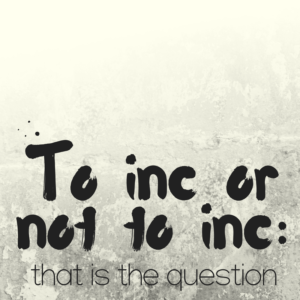 You’re on to something here for sure! While filing and name requirements vary by state, generally speaking, using “inc” in marketing materials and the common name isn’t usually required. You’re right that things look a lot cleaner without it. But there’s another important reason to ditch the “inc”: including it can sow confusion in the minds of the public and donors regarding your nonprofit status.
You’re on to something here for sure! While filing and name requirements vary by state, generally speaking, using “inc” in marketing materials and the common name isn’t usually required. You’re right that things look a lot cleaner without it. But there’s another important reason to ditch the “inc”: including it can sow confusion in the minds of the public and donors regarding your nonprofit status.
You see, “inc” denotes to many people a for-profit venture. And even though “inc” might be a formal part of your formal legal name (if required in your state), you are not required to use it in your marketing materials (in most legal stuff, yes, but audience-facing stuff, no). This is akin to me introducing myself to you as “Laura” instead of me telling you when you ask that “I am Laura Elizabeth Huth-Rhoades”.
Now, keep in mind that I am not a lawyer and this doesn’t constitute legal advice. Also keep in mind that laws relating to this vary by state. But by-and-large, you can focus on your name and keep the “inc” out of it for a cleaner look, and to ensure that your audiences aren’t distracted into thinking you are something other than a nonprofit organization.
Perception can be very important, and we don’t want to turn anyone off or away because they think yours is a profit-driven venture, right? So keep signing those legal docs with the “inc” but ditch it in your publicity and marketing materials.
– Laura at do good
PS. Here are a couple useful resources:
~~~~~~~~~~~~~~~~~~~~~~~~~~~~~~~~~~~~~~~~~
Dear do good:
My board doesn’t think we should spring for 1st class stamps for our appeal letters. They want me to save money in tight times. My gut tells me the investment will lead to better results. Do you have input to settle this debate?
– Looking for a 1st class impression
Dear 1st Class:
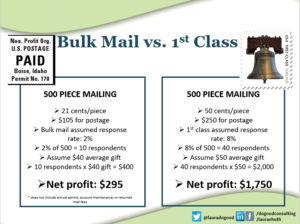
Sure! Your gut is right in this case. Using 1st class stamps usually nets much stronger results for mailed appeals. While your board’s interest in fiscal responsibility is laudable, in this case spending more on the front end yields much stronger results – and a far better fiscal picture. Take a look: in this 500-piece scenario below, paying just $145 on the front end raises $1,455 more in the final results. It boils down to this: for every $1 you spend on bulk mail, you get $2.81 back. But for every $1 you spend on 1st class postage, you get over $11 back! Talk about ROI!
If your board isn’t willing to spring for 1st class for all appeals, I would urge them to at least allow it for one of the appeals you send annually, preferably at year-end. Or, use donor segmentation to reach key prospects with these more personalized stamps. Regardless, be sure to test and monitor results to show impact over time and to make informed decisions moving forward.
– Laura at do good
~~~~~~~~~~~~~~~~~~~~~~~~~~~~~~~~~~~~~~~~~
Dear do good:
Our organization needs to start an e-newsletter and we want to know your top go-to programs.
– E-gads, we hope it’s easy!
Dear E-gads:
E-newsletters are an important proactive communication tool for nonprofits and critical to a group’s diversified outreach quiver.
There are some really easy-to-use, low-cost, high-impact options. All come with great list segmentation for custom communication with supporters, super design options to brand like a rock star, and strong analytics for analyzing and learning from who is (or isn’t) reading what.
do good‘s favs are: Constant Contact, Emma, MailChimp, and Campaign Monitor.
This is an important investment that – when done right – will most certainly pay for itself. Invest the time into proper set-up on the front end and your organization will not be sorry with the results!
– Your do good pals
~~~~~~~~~~~~~~~~~~~~~~~~~~~~~~~~~~~~~~~~~
A Few Good Databases?
Dear do good:
We’re looking for a good but inexpensive database system. What are you recommending these days?
– Data’s all I gotta say
Dear Data:
We recommend these: EveryAction, Frontstream (formerly GiftWorks), Neon, and Bloomerang. The first 2 are our favs: affordable and high-functioning with good customer service. Bloomerang’s good, but misses on some essential volunteer management and special events functions. CRMs (or databases) like this are critically important to well-run nonprofits, and when used right, can transform operations. Good luck and way to be proactive!
– Your do good pals
~~~~~~~~~~~~~~~~~~~~~~~~~~~~~~~~~~~~~~~~~
Your Favorite Nonprofit Rags?
Dear do good:
Call me old-fashioned, but I still love the tactile experience of reading magazines. What are your favorite paper nonprofit rags?
-Old-Fashioned
Dear Old-Fashioned:
We feel ya! Our favs to get our paws on are:
- AFP‘s Advancing Philanthropy
- GIFT‘s Grassroots Fundraising Journal
- Nonprofit Quarterly
- Chronicle of Philanthropy
- Stanford Social Innovation Review
Tell us what’s on your reading list!
– Your do good pals
